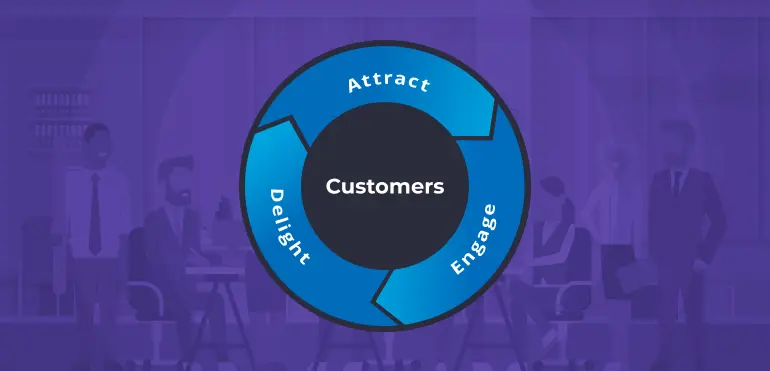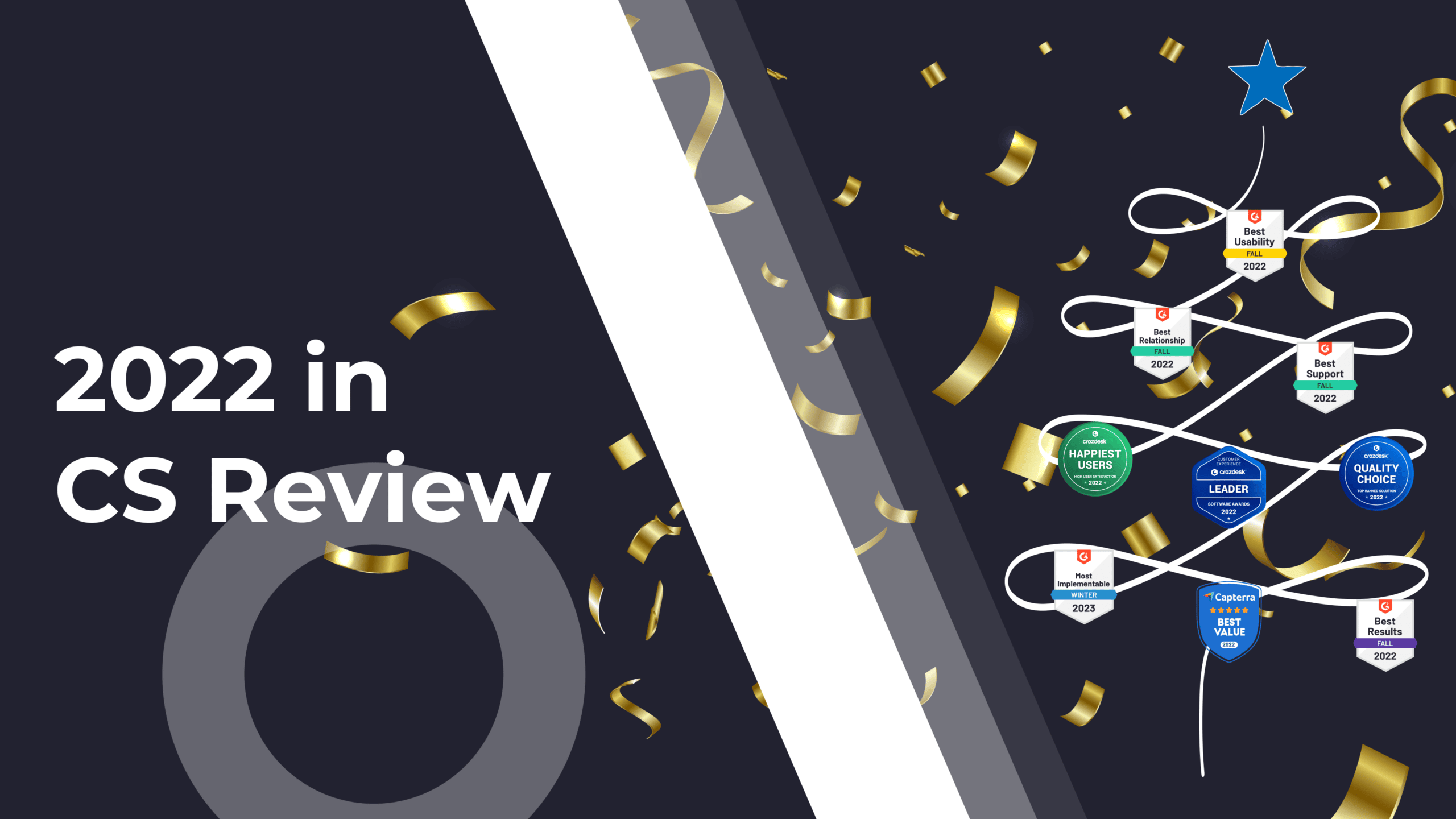Customer-centricity has become a hallmark of successful businesses in today’s highly competitive market.
The tiny word “Customer-centricity” is the reason why one feature-rich product never reaches its customer while a simple solution becomes a worldwide phenomenon. This especially rings true for SaaS businesses, which rely on customer retention and satisfaction to survive the ever-changing market.
Why does it happen that way? And what is the role of leadership in shaping a customer-centric organization?
But what exactly does being customer-centric entail, and why is it so crucial for your business, especially if you’re in the SaaS or Customer Success Management (CSM) sector? In this article, we’ll dive deep into the essence of customer-centricity, exploring:
- What It Means to Be Customer-Centric: We’ll define customer-centricity and discuss how it differs from traditional business models.
- Key Principles of Customer-Centricity: Discover the fundamental principles that guide customer-centric organizations.
- The Role of Leadership: Learn how leaders can shape and reinforce a customer-centric culture within their teams.
- Building Customer-Centric Processes: We’ll provide practical steps for integrating customer-centric strategies into your business operations.
- Training and Development: Explore how continuous learning and development underpin a sustainable customer-centric approach.
- Real-World Applications: Through case studies, see how leading companies have successfully implemented these strategies to achieve remarkable results.
What Does It Mean to Be Customer-Centric?
You might think every business is customer-centric. After all, companies roll out new products to attract new customers. Isn’t that the essence of customer-centricity?
No, not exactly. Being truly customer-centric goes way beyond just offering top-notch products and stellar customer service.
What Is Customer Centricity?
At its core, customer-centricity means that you’re putting your customers at the heart of your business decisions, every single time.
It’s not about shouting from the rooftops with a flashy neon sign that says, “Look what we’ve got!” Instead, it’s asking your customers, “What do you need? How can we help solve your problems?” and then shaping your business strategies around those answers.
Imagine you’re the top company that sells the most innovative online tools for team management. You’ve got a feature-rich app, vibrant design, and seasonal discounts. But your potential customers keep choosing other products. Not yours.
You might wonder, “Why do they leave us if our products outshine the competition?”
Let’s look at things from a different angle to answer this question.
Your competitors’ products might offer fewer features, but that is what makes them more user-friendly. Their landing pages might look old-fashioned and less stylish than your site. But who cares if their customers can find all the key info with two clicks?
In this imaginary scenario, one company adopts a product-focused approach. Others choose a customer-focused model and become more successful in the long run.
Let’s take a look at what sets these two business models apart.
| Goal | Product-Centric Approach | Customer-Centric Approach |
| Sell Products | Emphasizes product features and benefits | Serve customers |
| Product positioning | Emphasizes product features and benefits | Focuses on how products solve customer problems and meet their needs |
| Organizational focus | Internal: Product development, innovation, and marketing | External. Understanding customer needs, preferences, and behaviors to create tailored solutions |
| Success metrics | Sales volume, market share, and revenue | Customer satisfaction, lifetime value, and retention rate |
| Customer feedback | Used mainly for product improvements | Used to shape overall business strategy and decision-making |
| Innovation driver | Advancements in technology and features | Insights from customer data and feedback |
You see examples of this all the time in the market: companies like Slack and Zoom have soared not just because they offer great products, but because they excel at addressing customer needs in a way that seamlessly integrates into daily workflows. Customer centric companies don’t just sell a product; they solve real-world problems.
Irina Vatafu, a noted CX expert, and head of CS at Custify, explains, “The essence of customer-centricity is the transition from selling products to selling experiences. It’s about making the customer feel they are the most important part of your business. This mindset shift leads to profound changes in how businesses operate and innovate.”
In practice, being customer-centric might mean tailoring your product developments to feedback received directly from customer interactions or ensuring that your customer service team goes above and beyond to turn even dissatisfied customers into brand advocates.
In essence, a business that breathes customer-centricity doesn’t just aim to meet expectations but consistently seeks to exceed them, ensuring every customer interaction feels personal and valued. This is the kind of approach that not only retains customers but also turns them into vocal supporters of your brand.
Key Principles of Being Customer-Centric
Applying a customer-centric lens involves the adoption of key principles:
1. Prioritize Customers’ Needs and Experiences: Every decision, product, or service should revolve around enhancing the customer experience.
Example: Netflix uses viewing data to not only recommend movies and shows but also to decide which new content to produce, ensuring offerings align closely with viewer preferences.
2. Leadership Commitment to Customer-Centric Values: Company leaders must visibly and consistently demonstrate their dedication to placing customers at the heart of business decisions.
Example: HubSpot’s executives regularly participate in customer support forums and directly engage with user feedback on social media, demonstrating their commitment to listening and responding to customer needs.
3. Align Employees with a Customer-Centric Mindset: Ensure that all employees understand and are engaged in delivering customer-centric outcomes.
Example: At Slack, employees across all levels are encouraged to participate in direct customer support and success interactions during their onboarding process and beyond, fostering a deep understanding of customer needs and challenges.
4. Design Products with Customers in Mind: Develop new products or adjust existing ones based on what will serve the customers best, not just what is technologically feasible or most profitable.
Example: Canva frequently updates its design tools and templates based on direct user feedback and usage patterns, ensuring the product evolves in line with customer needs and creative trends.
5. Build Long-lasting Relationships with Customers: Focus on nurturing enduring relationships rather than just achieving one-time sales. This strategy not only increases customer lifetime value but also fosters brand loyalty.
Example: Sephora’s Beauty Insider program offers tailored rewards, personalized product recommendations, and exclusive events to engage customers over the long term, encouraging ongoing interaction and loyalty.
The Role of Leadership In Building a Customer-Centric Organization
If you’re already picturing your customer-focused business, let me inspire you more. Research by Deloitte and Touche found that customer-centric companies are 60% more profitable than their competitors!
Feel inspired? You’re probably wondering how to draft your action plan and present it at your next team leaders’ meeting. That’s a great approach! But let me tell you one more thing:
Transformation of your company’s processes is crucial, but it’s not the first step you should take. The driving force that powers the customer-centric transformation is you!
Let’s look at how you can make an impact as a leader of a customer-centric organization:
You Set the Vision and Values
Announcing your transition to a customer-centric model is not enough. It’s up to you, as a leader, to clearly define your new vision and values based on empathy for your customers. Ensure these values are actionable—something your employees can rely on when doing their jobs.
Embed Customer-Centric Training:
It all starts with education. Leaders must champion and invest in specialized training programs that elevate customer-centric skills and awareness throughout the team. Think role-playing exercises that dive into customer needs or interactive scenarios that challenge employees to think from the customer’s perspective.
For instance, utilizing platforms like Skillsoft or Coursera can provide your team with the courses they need to boost their skills in real customer-centric practices.
Establish Clear Customer-Centric Goals and Metrics:
Next up, setting clear, measurable goals is crucial. This isn’t just about hitting revenue targets but also about how customers feel about their interactions with your company.
Implementing Customer Success Platforms like Custify can help you track real-time metrics such as Customer Satisfaction Scores (CSAT), Net Promoter Scores (NPS), or Customer Effort Scores (CES). This tech lets you see not just the numbers but the stories behind them.
Foster Open Communication and Feedback Loops:
Open lines of communication are key. Leaders should foster an environment where feedback is not only encouraged but acted upon. This means tuning into feedback from both customers and team members.
Using CRM tools like Salesforce or HubSpot can help you gather and analyze this valuable feedback efficiently, ensuring it’s easy for everyone to find and use.
Recognize and Reward Customer-Centric Behaviors:
Don’t just expect great customer-centric behavior; recognize and reward it. Public acknowledgment of employees who demonstrate outstanding service can reinforce the importance of these actions and set a standard for others.
Integrating a recognition system within your CRM that tracks and rewards these actions can motivate your team to keep putting customers first.
You Lead by Example
Tony Hsieh, the former CEO of Zappos, once said, “Customer service shouldn’t just be a department. It should be the entire company.”
As a leader, you should commit to putting the customer first before changing your goals, products, services, and processes. Build your vision first and act on it. Show your employees what putting customers first looks like, and everything else will fall into place.
How to Build Customer-Centric Processes
Now, let’s take actionable steps toward building a customer-centric organization. You can use them to refine your existing processes and create new ones from scratch.
Gather and Analyze Customer Feedback
If you’re a well-known brand, you probably got hundreds of reviews from your customers on Sitejabber or Trustpilot. That’s great! You’ll need them or our next steps because there’s a lot of homework to do.
You (or someone on your team) should gather feedback from all possible channels, including social media posts, customer support emails and chats, and online reviews. If carefully analyzed, these data can provide valuable insights into your customer pain points and needs. However, you shouldn’t rely on customer feedback alone.
People generally keep some of their thoughts to themselves, and so do your customers. This creates a blind spot – new areas for improvement that you can’t identify because no one has mentioned them in a review or comment.
So, the best approach to get a wider range of customer perspectives is to combine customer feedback with other sources of data, such as surveys and user testing.
Implement Customer-Centric Metrics
You’ve got a pile (or gigabytes) of feedback and customer insights. Let’s make sense of it all. Our goal is to use metrics that reflect how your customers feel about your digital products. These include:
- Net Promoter Score (NPS)
- Customer Satisfaction Score (CSAT)
- Customer Retention Rate (CRR)
- You can learn more about others here.
Seek ways to improve your processes
Take your time to decide which metrics matter most for your business. For SaaS companies, finding the right KPIs requires focusing on your customer’s journey and specific goals. You don’t have to stick to the particular KPIs. Instead, review your processes and make necessary changes.
Building a Customer-Centric Culture: Training and Development
Your team needs a basic set of skills and knowledge to make a transition towards a customer-centric culture. Here’s an action plan you can use both for initial training and ongoing development:
Provide Training and Resources to Implement Customer-Centric Thinking
Before you invest in any well-known training program or develop your own, think about the unique roles and job goals your employees have. Ask yourself, “How can they contribute to creating a customer-centric culture? What specific skills and knowledge do they need to develop?”
The answers to these questions will help you determine the ratio of general training. They will also help you determine the social learning and on-the-job training you should provide.
Nolan Hout, Vice President of Marketing at Compunnel Digital and Infopro Learning, suggests using the 70-20-10 rule for that. He says that 70% of learning should come from “on-the-job” experiences, 20% from interaction with coaches and mentors, and 10% from formal education and training.
I believe, however, that companies should tailor this ratio to employees’ specific needs and roles.
For example, CS team members will get in-person training. They can boost their skills through intense training with coaches, which offers flexibility and interactivity that formal education may lack. Software specialists, on the other hand, would benefit more from formal education and on-the-job experiences than coaching. Ultimately, you can adjust the 70-20-10 rule to provide your employees with the most relevant and effective training.
Here’s one more thing you can’t afford to forget: assessment. Set aside time to evaluate the effect your training has on customer satisfaction, as we discussed in the previous section. Find a link between the skills your employees gained from training. Also, find a link between those skills and customer satisfaction. This will help you focus on what really matters for your business.
Specific training and courses to consider:
For businesses looking to enhance their customer-centric development, there are several reputable training providers that offer specialized courses:
- CX University provides comprehensive courses on customer experience management, ranging from foundational to advanced strategies, tailored to help professionals enhance their CX skills.
- Disney Institute shares insights into Disney’s approach to customer service excellence, offering practical workshops that translate magical experiences into actionable business practices.
- Ritz-Carlton Leadership Center teaches the methods behind the world-renowned customer service of Ritz-Carlton, applicable across all industries that prioritize customer satisfaction.
- Service Strategies offers certifications that delve into strategic service management, helping organizations align their operational activities with customer-centric objectives.
- Dale Carnegie Training boosts team performance and customer service skills through dynamic training sessions that emphasize human relations principles.
Encouraging a Culture of Learning Within the Organization
What stops people from learning? I call this the “3 learning barriers” rule: lack of time, money, and interest. Let’s model the scenarios where you help your employees overcome these barriers:
- Lack of time. Don’t raise your brows just yet because I’m not going to suggest cutting down on work hours. Instead, provide your employees access to online courses that often have flexible schedules.
- Lack of money. Your people would read all these books and take courses if they could only afford them. Assign a budget for learning and development or ask your HR department to look for free training options.
- Lack of interest. The best way to spark interest in someone is to lead them by example. Spare a minute or two from your busy schedule to tell them about new course you’re taking. You won’t see an immediate effect, but gradually, more and more employees will start following your lead.
Develop Leadership Skills Necessary for Driving a Customer Mindset
At first, it might seem scary to give freedom and responsibility to your employees. But, these qualities are crucial for any member of a customer-focused organization. In such a scenario, they become leaders of their own tasks and take ownership of the customer experience.
For those who got used to the waterfall framework of task management, this new approach might seem hard to adapt to. But you and your top management can help them in the process. Tech employees some basic leadership skills like:
- Empathy
- Effective communication
- Problem-solving
Case Studies
The transformational power of customer-centered leaders is immense. Let’s look at how their ideas have brought success to real-life companies:
Adobe
Everybody knows Adobe as a leading customer-centric company that brings fresh ideas to the table for creative digital solutions. But they weren’t always like that. Two decades ago, Shantanu Narayen, Adobe’s President and CEO, faced the challenge of shifting his company from a product-based approach to a solution- and customer-centric one.
Challenges:
- Lack of collaboration between teams
- Isolated decision-making
- The unwillingness of senior leaders to make their own decisions
Solutions:
- Narayen invested in an external training program despite having in-house expertise.
- He chose flexibility and adaptability as key values and used them to design new company processes.
- Narayen held personal one-to-one meetings with team members to encourage feedback and exchange of ideas.
- The company used innovative software. It calculated the impact of each employee’s role in the global customer journey.
Results:
- The company survived a leadership crisis and provided innovative and effective solutions in a highly competitive market.
- Adobe increased revenue by more than 85% since adopting a customer-focused model.
Zoom
Zoom reached its maximum potential when the entire world suffered from global COVID-19 lockdowns and remote communications. Eric Yuan, founder and CEO of Zoom, didn’t just happen to be at the right place at the right time. He made several important decisions.
Challenges:
- Tough competition in the video conferencing industry
Solutions:
- Shore focused on creating a user-friendly platform that meets the needs of all users, from small businesses to large corporations.
- Zoom has a user-focused approach. The company focuses on building strong relationships with customers and encouraging their feedback.
Results:
- The company’s sales rose more than 40% in the fourth quarter of 2020 compared to the same period in 2019.
- Zoom leads the videoconferencing software market with a market share of 57%.
Conclusion
You’ve made two steps towards building a customer-centered company. The first one happened when you typed your question in the search field. You’ve landed on this page. And the second one happened a second ago. You finished this read. I hope my post has not only inspired you but also equipped you with practical insights on adopting a customer-centric approach in your business.
Ready to take the next step? Implement what you’ve learned with an advanced tool designed to enhance your efforts. Try using Customer Success Software like Custify – it’s specifically designed to help you streamline your customer-centric strategies by providing real-time insights and CS metrics that matter.




